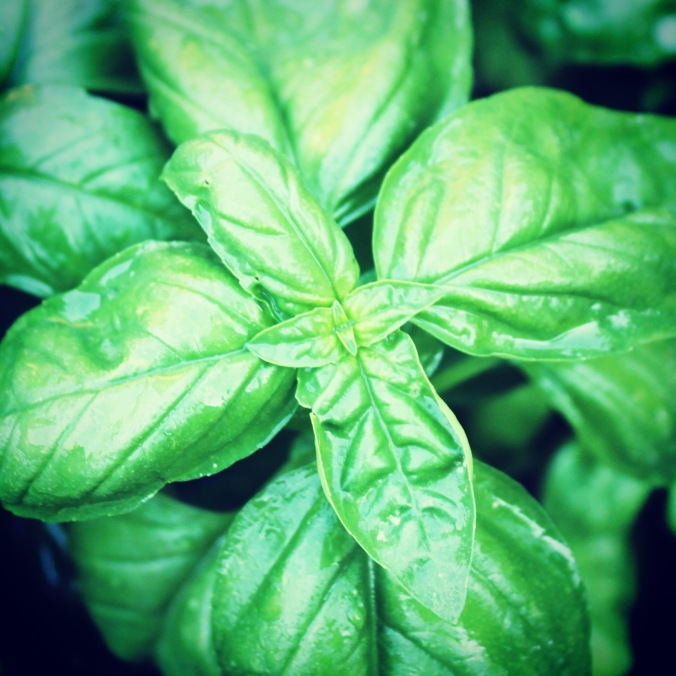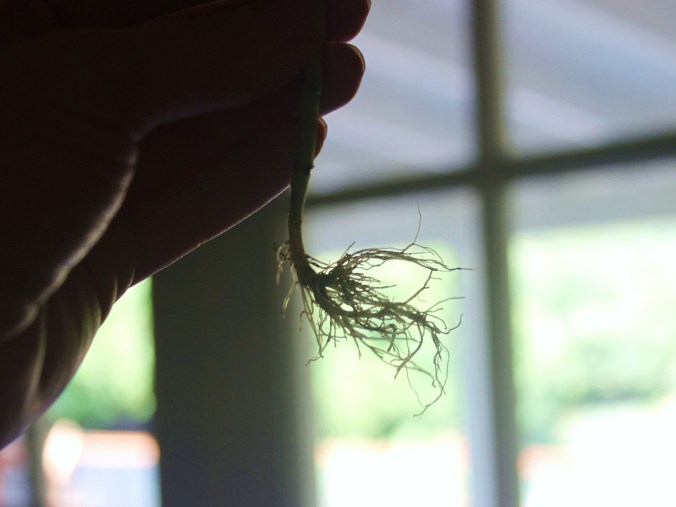If I could convince you to grow one herb in your garden, it would most certainly be basil. With its lush green leaves, soft fragrance, and beautiful blooms it is the star of the herb garden. Basil is known for a wide variety of culinary and medicinal uses. It can also be used in the home to freshen the air and brighten spaces. As such, I love to grow it in my garden for as long as the growing season allows.
Did I mention, basil is also very photogenic?

Through years of trial and error, I have found that the key to a successful basil harvest is pruning and propagation. Pruning is essential for plant health, flavor, and longevity. Propagation can save you money buying more plants and increase your harvest. In this post you will find out just how easy it is to do both, and have your best basil harvest yet!

How & When to Prune
The first pruning is the most important for creating a bushy, multi-branched plant. When the young basil has developed three sets of leaves, and is over 6 inches tall, cut the main stem right above the second set of leaves (see photo below). This will make the plant more stocky and it will produce more leaves and intense flavor.
 Remove any blossoms that appear by pinching them off. Prune your basil plant every two to three weeks throughout the summer. That’s all there is to it! Easy peasy!
Remove any blossoms that appear by pinching them off. Prune your basil plant every two to three weeks throughout the summer. That’s all there is to it! Easy peasy!
Tip: I find a sharp pair of scissors works well for pruning basil.

How to Propagate and Grow
Plant propagation is the process of creating new plants from a variety of sources: seeds, cuttings, bulbs and other plant parts. In the case of basil, you can create new plants from your pruned stems in several easy steps.
For this you will need:
- Water
- Vessel to hold water (I like using a mason jar or small vase)
- Basil cuttings
- Liquid Plant Fertilizer (optional, but highly recommended)
Step 1. Fill a vessel with water and add a drop of liquid fertilizer. The fertilizer will encourage strong root growth.

Step 2. Prep your basil cuttings for propagation by stripping off the bottom set of leaves.
The stem that sits in water should be free of leaves so that bacteria does not form during the rooting process. The leaves you removed can be used for cooking or drying.

Step 3. Place cuttings into prepared water vessel. You should see roots starting to develop after 7-11 days. Replace with fresh water every 3 days (no need for more liquid fertilizer) .

Keep the stems in the water until they have about an inch of root growth (see roots on the left pictured below). Some stems will develop roots faster than others. Those that take more time to develop roots can be left in water for an additional 3 days. If roots don’t develop after this point, discard the stems.

Step 4. Time to plant! Pick out your stems with the strongest roots. These will get planted first.

Gently place your rooted basil stems in the soil, covering the roots completely and packing soil down firmly. Carefully water, using a fine mist, until the roots have grown enough to support the plant.

Step 5. Enjoy your best basil harvest ever! 🙂




I love this! Was only a few days ago i was looking on google how to look after my basil plant but this is a much easier and complete explanation! may i ask, i am trying to grow it indoors , do you think maybe its not a good idea? should it be outside? 🙂 thank you
LikeLiked by 1 person
Hello! Happy to hear the post was helpful to you! Growing basil indoors is possible but has its’ own set of challenges. One being, lack of direct sunlight. I have found that basil needs lots of direct sunlight to thrive and sunlight from a bright window is simply not enough for the plant to flourish. Another challenge of growing basil indoors is that it needs to be placed in a pot. Basil will typically survive in a small pot for about 3-4 weeks, and then the roots have no more room to grow and the plant begins to dry out. Basil grows best when potted in a large pot or directly in the soil. Hope this helps and happy gardening to you!
LikeLiked by 1 person
Thank you for this 🙂 now I know what I am doing wrong 🙂
LikeLike
Very clear instructions and I’ve bookmarked this page for next Spring (well, Spring in 3-4 weeks DownUnder in Australia).
I used to have an enormous herb garden some 25-30 years ago, but mainly for the interest in Herbal Medicine more so than culinary, although my efforts introduced my elderly Mother to use more herbs in cooking (other than the usual Rosemary and Parsley).
Unfortunately, the herbs & salad greens I grew last Spring (just a few months after moving to this 3rd floor apartment) only lasted about 5 months and ended up being eaten by Cabbage Moth Caterpillars and smothered in thrip-like insects. My enormous Rosemary plant is the only thing left. Despite no direct sun, it’s growing like crazy.
Reading your blog is stirring my interest in having another go in this south-facing balcony space.
Thanks for sharing.
LikeLiked by 1 person
Hi Vicki! I’m glad you found the post helpful and that it stirred your interest to have another go at growing basil! Sorry to hear about the cabbage moths… they are the worst! You should check out my post on how to organically eradicate them from your garden: https://neverthyme.com/2016/07/15/cabbagewormeradication/
I had a huge problem with them in years past but finally have a handle on things. Growing basil is so much more fun when YOU get to eat it and not the CATERPILLARS! 🙂
LikeLike
This is such a help! I use basil all the time and this year was my best crop yet. I was told to keep pinching back the tops so that they don’t flower as they then stop producing well, is that true? In following that advice I found my plants did way better but after reading this my guess is your pruning schedule will essentially do the same thing.
I can’t wait to start next year!!
LikeLiked by 1 person
I love my basil in the garden! Thank you for such clear instructions on how to care for it. I do everything by trial and error. Not always the best way. I have a question: my basil has been growing since about March. I still have at least a month of growing weather here in North Florida. The bottom stalks of my basil has turned brown and trunk like. Is this normal? Is it because I didn’t prune enough when it was young?
LikeLiked by 1 person
Hello Rebekah! I’m glad you enjoyed the post! To answer your question – yes, it is normal for the basil stalks to turn brown as woody. It usually happens when the basil is near the end of its life. When it starts to turn brown, I like to cut off a few stems and propagate a new basil plant. By doing so I can usually have healthy and lush basil leaves growing until the first frost! Hope this helps! 🙂
LikeLiked by 1 person
I LOVE fresh basil! The smell, the look, and definitely the taste make it a must-grow in my garden every year. I transform most of my basil into pesto that stays in the freezer until I’m ready to use it. I simply can’t grow enough, but I think your wonderful tips are goin to change that! And thank you for the information on growing basil indoors – I’ve thought of trying it several times, but never got around to it. There’s no way any of my windows get enough sunlight, so now I’ll just skip that and work on my basil propagation skills. Thank you for such an informative post!
LikeLiked by 1 person
Thank you! I’m so happy you found the post useful! 🙂
LikeLike
Love basil; thanks for a great post!
LikeLiked by 1 person